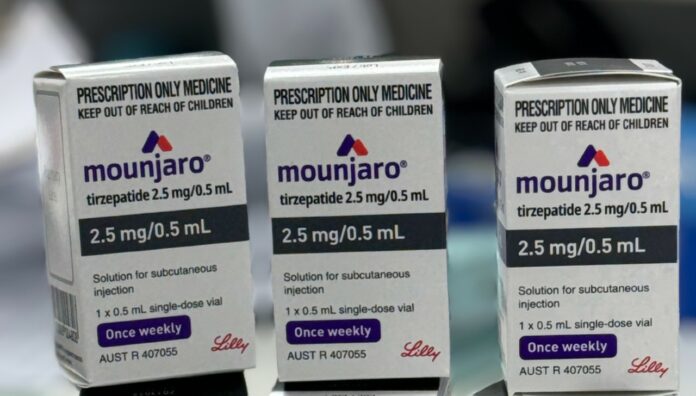With supply shortages of other diabetes therapies such as semaglutide persisting, off-label prescribing of Mounjaro for weight loss has become more common.
Along with prescribing for off-label indications, pharmacists are also receiving prescriptions with instructions for multi-dosing out of a single-dose vial, and requests for patient education around self-administering multi-dose injection technique, as outlined in PDL’s recent practice alert.
Australian Pharmacist explains how to ensure the medicine is prescribed and supplied safely and appropriately for each patient.
1. While off-label use is not illegal, pharmacists must ensure safety
Mounjaro (tirzepatide) – a long-acting dual glucose-dependent insulinotropic polypeptide (GIP) and glucagon-like peptide-1 (GLP-1) receptor agonist used in the treatment of type 2 diabetes – was first listed on the Australian Register of Therapeutic Goods on 10 July 2023.
While doctors are responsible for prescribing Mounjaro for off-label use, pharmacists are equally responsible for safe and appropriate supply, said PSA New South Wales State Manager Amanda Fairjones MPS.

‘Pharmacists are required to determine whether a medicine is safe and therapeutically appropriate when dispensing a medicine. This obligation means greater scrutiny in off-label use where this includes determining if there is adequate evidence supporting the indication.’
Minimum actions for dispensing:Action 2 The pharmacist assesses the information gathered and reviews the prescription or order to determine if dispensing the therapeutic good for the patient is:
Reference: Professional Practice Standards, 2023, Version 6, Pharmaceutical Society of Australia |
To do this, before dispensing the medicine, pharmacists must:
- confirm with the patient that the use of the medicine for weight loss is off-label
- obtain informed consent from the patient about off-label use
- provide additional information when counselling, ensuring patients have the opportunity to ask questions.
2. Advise against multi-dosing Mounjaro from a single use vial
Mounjaro is a preservative-free, sterile solution for subcutaneous injection that comes in single-use vials in the following strengths:
- 2.5 mg/0.5 mL
- 5 mg/0.5 mL
- 7.5 mg/0.5 mL
- 10 mg/0.5 mL
- 12.5 mg/0.5 mL
- 15 mg/0.5 mL
‘Because off-label use is not covered under the Pharmaceutical Benefits Scheme, it’s a cost-saving measure for the patient to be prescribed higher strength vials for multi-dosing,’ said Ms Fairjones. ‘But this doesn’t professionally justify unsafe supply.’
Caroline Diamantis MPS, a Sydney-based pharmacy owner and Vice President of the PSA, has received several prescriptions for higher-strength vials of Mounjaro with instructions from GPs for multiple doses to be drawn up from a single use vial.

After seeking confirmation from the manufacturer, Eli Lilly, that the medicine should be used as a single-use vial, Ms Diamantis has advised her patients accordingly – followed by a phone call to the prescriber.
‘Eli Lilly, says the medicine should be used as a single dose, so it’s important pharmacists explain to patients that multidosing may be unsafe and could lead to contamination,’ agreed Ms Fairjones.
However in Ms Diamantis’ experience, prescribers have been willing to adjust the script.
‘Every time I’ve called a doctor and strongly recommended that Mounjaro is a single-dose vial, they have appreciated the recommendation and decided it’s not worth the risk,’ she said.
If the patient is insistent on multi-dosing, then it’s up to the pharmacist to use their professional judgement about what to do next.
‘The pharmacist has to consider all their options and decide, depending on the individual circumstances of the patient, whether it’s safe to supply the medicine,’ added Ms Fairjones.
‘If you are not satisfied that multi-dose administration from a single-use vial is safe, you can and should decline supply – and document the reasons for this approach.’
3. Consider whether self-administration is safe
Many pharmacists are encountering patients who have been advised pharmacists can train them how to self-administer Mounjaro.
One of the first patients who presented to Ms Diamantis’ pharmacy with a prescription for Mounjaro was a woman in her 70s, riddled with arthritis, who had poor dexterity in her hands.
‘The patient said, “the doctor told me you’d show me how to self-inject”,’ she explained.
At this point, Ms Diamantis asked the patient if she had the capability to draw up and inject the medicine.
‘I said, “Do you think you’ll be able to hold this small vial with one hand, clean the top with alcoholic swabs, pierce the thick flange, expel the air and inject the small amount of fluid via subcutaneous injection without causing any bruising?”’ she said. ‘The patient said straightaway that wasn’t realistic.’
Educating patients to self-administer Mounjaro may be within the pharmacists scope of practice, if they have the knowledge, skills and authority to do so.
‘If pharmacists decide it’s within their scope of practice, it’s their responsibility to ensure patients are capable of self administering,’ said Ms Fairjones.
Pharmacists should also use their professional judgement to assess the patient is competent to administer the medicine by:
- asking open-ended questions, such as, ‘can you tell me the steps you will take to self-administer the medicine?’
- confirming the patient’s knowledge, including the size of the dose, and vial size
- watching the patient administer their first dose.
‘This is important, because there is concern the patient will go home and administer the whole vial at a dose up to five times higher than what was prescribed,’ said Ms Fairjones.
‘The PSA is aware this has occurred, despite extensive patient counselling by pharmacists.’
The Poisons Information Service can be contacted in cases such as these to manage potential adverse events.
Referring to the PPS, if the pharmacist has any concerns or determines dispensing the therapeutic good for the patient is not safe or therapeutically appropriate, they must take appropriate actions including:
- implementing interim measures, such as deferring supply or supply limits
- facilitating access to the medicine
- discussing and resolving any issues with the prescriber.
‘If a patient intends to use the medicine for weight loss, the timing of the first dose is generally not urgent. If you are concerned for patient safety, you can and should delay supply until you have been able to resolve these concerns,’ added Ms Fairjones.
4. Only administer the medicine as a single-dose in the pharmacy, then discard vial
Immuniser pharmacists with the authority, skills and knowledge could offer a medicine by injection service in their pharmacy.
Importantly, pharmacists must only use the medicine as a single-dose vial when administering it to patients, said Ms Fairjones.
‘Pharmacists must follow the manufacturer’s instructions,’ she said. ‘The vial has expired once the first dose has been drawn out. Just like you wouldn’t supply a vaccine from an expired multi-dose vial, you should not facilitate administration of injectable Mounjaro from an expired vial.’
If the first dose is administered to a patient in the pharmacy as part of an education process, the rest of the vial must be discarded – irrespective of the instructions on the prescription.
‘If pharmacists take one dose out of the vial and give it back to the patient, this is essentially providing them with an expired medicine,’ said Ms Fairjones.






 ‘We’re increasingly seeing incidents where alert fatigue has been identified as a contributing factor. It’s not that there wasn’t an alert in place, but that it was lost among the other alerts the clinician saw,’ Prof Baysari says.
‘We’re increasingly seeing incidents where alert fatigue has been identified as a contributing factor. It’s not that there wasn’t an alert in place, but that it was lost among the other alerts the clinician saw,’ Prof Baysari says.





